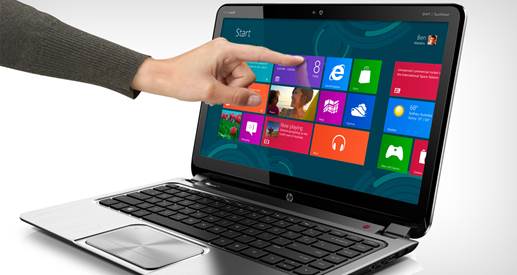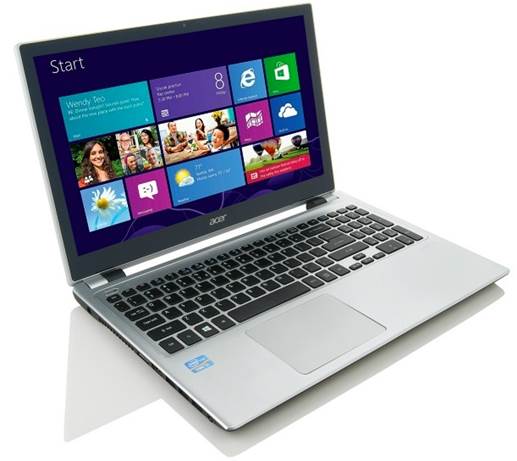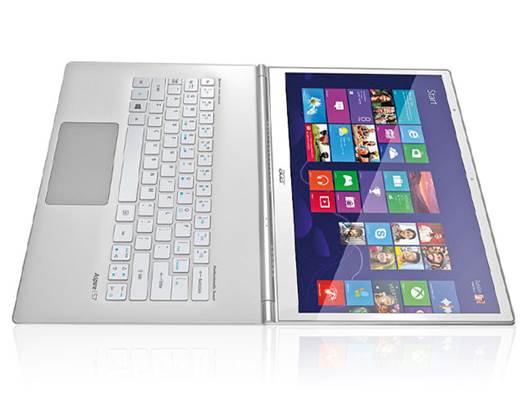Touchscreen laptops
When Windows 8 first arrived, complete with
its two very distinct personalities, most people thought immediately of tablets
as the primary beneficiary and perhaps of Transformer-style hybrid devices next.
By contrast, slapping a touchscreen onto a laptop seemed a cobbled together
solution, one that wouldn’t really make the best of the radical new Metro
interface (as it was called at the time). To put it bluntly, we’d been scarred
by our experiences with Windows 7 and touch.

Touchscreen
laptops aren’t as flexible as their tablet and hybrid rivals, but they’re
comfortable to use on your lap
But then we used one. More than one. In
fact, we used a lot of touchscreen laptops, and it’s no understatement to call
the experience something of an awakening. Long before the first proper Windows 8
devices arrived, editor Barry Collins could be heard on the PC Pro
podcast singing the praises of an old (and at the time rare) touchscreen laptop
onto which he’d crow- barred an early preview of the OS. It just felt natural,
and if typing and prodding in unison was such an unexpected treat on that old
thing, even with non-optimized touch drivers, surely today’s dedicated touchscreen
laptops must be even better to use.
To find out whether this single enhancement
makes for a better experience than a tablet paired with a keyboard, we took our
selection of touchscreen Windows 8 laptops for a test run, trying them in a
variety of environments and uses.
Strengths
Let’s get one thing straight from the
outset: a touchscreen laptop is still very much a laptop first and foremost. If
nobody told you that you could prod the screen, you’d probably see nothing
unusual about them, with their classy, thin chassis, their day-long batteries
and their full-sized keyboards and touchpads. With no complicated mechanisms to
get in the way of working comfort, they’re all pretty usable in this mode –
certainly more so than the more intricate Windows 8 hybrid designs. In fact,
it’s best to view the touchscreen as an added bonus.
However, it’s a very handy bonus to have.
We’ve criticized touch monitors in the past, bemoaning the tired arms that
inevitably result from reaching out to touch a vertical display, but a laptop
screen sits much closer to you than a monitor and we’re only talking about the
occasional tap here.
The main beneficiary is the new Start
screen, which immediately feels more user-friendly than it does with a mouse.
Swiping left and right, and tapping an icon to open an app, you can see what
Microsoft was aiming for when it created such a dramatically different
interface. Plus, if you can’t find what you’re looking for at any point, you can
always type the first few letters of an application’s name as you would with a
standard laptop.

Touchscreen
laptops improve Windows 8’s usability
We also like swiping in from the edge of
the screen to bring up the Charms menu, although we should point out that many
new Windows 8 laptops – touchscreen or otherwise are appearing with dedicated
Charms keys in the top row of the keyboard. Taking the positive outlook, this
means you can easily access any Charms menu, regardless of whether your fingers
are resting on the touchpad or the keyboard.
It’s worth emphasizing just how smooth the
combination of typing and touch can be. Once you get into the routine of
tapping and swiping on the screen, but keeping a hand on the keyboard to search
or fill in boxes – no onscreen keyboard necessary – the speed you can pick up will
come as a pleasant surprise.
A final strength, and we appreciate this
isn’t necessarily the case with all of the devices in this section, is that
there’s less pressure on manufacturers to come up with something desperately
thin and light. These devices don’t need to convert into a tablet to rival the
iPad or the Nexus 10, so a dedicated touchscreen laptop will often have a bit
more space around the base for a range of ports and connections, and there’s
more room inside for a bigger battery. In short, you’ll get everything you’ve
come to expect from a laptop, which can’t always be said of the hybrid devices.
Limitations
What can’t a touchscreen laptop do? Well,
it obviously won’t be as easy to use as a dedicated tablet while you’re
standing up, although it’s still possible. Holding the base in one hand and
prodding the screen with the other is something you won’t want to do for more
than a few minutes, and it quickly reveals those models that boast a good,
stiff hinge; prod a laptop that doesn’t and the screen gradually droops
backwards.
There are models that work as a stand-in
for a tablet a little better than others. For example and we appreciate this
may be stretching things a bit – the further the screen tilts back, the easier
it is to ignore the keyboard and concentrate on the screen; if a laptop opens
all the way back to lie flat, it can be more comfortable to prod on your lap,
and the keyboard is still there if its required.
Screen problems

Acer’s
Aspire S7 folds flat to give a more tablet-like experience
The other thing to be aware of is how
touchscreens are constructed. Generally, the display sits under a glass layer,
which itself sits beneath several additional layers of touch-related technology
more layers of glass, along with layers of electrodes. We’re starting to see
the electrode layers built into the top sheet of glass on some high-end
laptops, but the point is that there will always be extra layers when you’re
using a touchscreen, and that can have a detrimental effect on usability in a
number of ways.
First, the process of converting your finger
prods into electronic input requires processing power, which can have an impact
on battery life. The controller technology is getting more efficient by the
release, however.
The touch layer also has an effect on the
image quality of the display. Touchscreens are often more reflective than their
non-touch siblings, which can be annoying under harsh office lighting. We still
occasionally see touch layers that add grain to the displayed image, although
these are less common than they once were.
On some screens (often on cheaper devices)
there’s also a noticeable gap between the touch layer and the LCD panel beneath
it, which can cause ghostly double reflections, not to mention the feeling of
disconnection you get from prodding a surface that’s suspended very slightly
above the graphic you’re attempting to manipulate.
Finally, there’s the price: a touchscreen
will always add a premium, although again, this has been coming down as the
technology becomes more popular with manufacturers.
These issues aren’t exactly deal-breakers
in all fairness, only photo-editing professionals and enthusiasts need weigh up
the reduction in picture quality against the benefits touch can bring, and
battery life is good on most touchscreen devices. However, they’re worth
bearing in mind if you were thinking of opting for a touchscreen over a normal
one.
Who wants one?
All in all, it’s a strange group of devices
this month. We’re constantly told tablets are the future for consumers –
they’re selling by the shipload, and everyone seems to want one – but using a
touchscreen laptop for a day makes that seem a rather bold and over-the-top
statement.
There’s still nothing to match a laptop for
genuine productivity, and these touchscreen models add an extra layer of
much-needed logic to Windows 8 that new users may feel is missing with only a
mouse and keyboard. For many users, having the novelty of touch added to a
familiar device will be the best way to get used to the new environment. And
with prices starting as low as $675, it’s tough to find fault.
That said, a touchscreen laptop won’t
provide everyone with the best possible Windows 8 experience. It isn’t at all
ideal for software that works entirely through touch, so if you can see
yourself making extensive use of the slowly growing number of Windows Store
apps, you’ll be better off with a tablet or a hybrid.